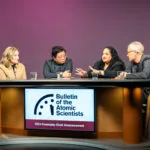Crispr goes global: A snapshot of rules, policies, and attitudes
By Kathleen M. Vogel, Students from PLCY 306 | June 5, 2018

The gene editing technology Crispr has been in the news a great deal over the last few years. Just last week, the prestigious (and lucrative) Kavli Prize was awarded to the technology’s originators—UC Berkeley’s Jennifer Doudna, her French collaborator Emmanuelle Charpentier, and a Lithuanian researcher who made his Crispr discoveries independently. But the lion’s share of media coverage has focused on the revolutionary technology’s vast potential for improving human life and its disturbing potential for harm.
Crispr, compared to traditional methods of genetic engineering, enables more precise and efficient genetic modifications. The modifications are achieved by using small strands of RNA to guide a Crispr-associated protein, such as a Cas protein, to a specific location on an organism’s DNA. The Cas protein then cuts the DNA at an exact location, allowing an altered gene to insert itself at that location—or allowing modification of the nucleotide sequence at that site. All these attributes have sparked great excitement, and provoked many concerns, regarding the economic, social, biosafety, bioethical, and biosecurity implications of Crispr-related work. In the United States, the US National Academies of Science have hosted a variety of domestic and international meetings and issued reports on the potential promises and pitfalls of gene editing. Gene editing was included in the Worldwide Threat Assessment reports submitted to Congress by the Office of the Director of National Intelligence in 2016 and 2017.
Despite the scientific and policy interest in Crispr within the United States, no published studies have described how gene editing technologies are developing within and across specific country contexts. Such issues are important to understand because gene editing techniques are being developed and implemented in diverse national and transnational environments—where unique historical, social, economic, scientific, and political factors can shape the adoption and use of these technologies. Gaining a better understanding of the specific issues that countries face in their development and use of gene editing technologies—as well as an awareness of issues that cut across borders and cultures—can shed light on the interplay among, on the one hand, gene editing, and on the other, public opinion, regulatory mechanisms, and policy considerations in nations around the world.
To step into this gap, I conducted a research project during the spring of this year as part of an upper-level undergraduate course on public policy that I teach at the University of Maryland. Forty-three students were assigned into teams to assess gene editing developments from 2012 to 2018 in the following countries: Australia, Canada, China, France, Germany, Iran, Israel, Jordan, Kuwait, Malaysia, Qatar, Saudi Arabia, Singapore, South Korea, the United Kingdom, and the United States. The students utilized a variety of information sources to gather technical, social, political, and economic data related to gene editing in these countries. Sources included databases such as Web of Science, Science Direct, and EBSCO. Students also sought information through search engines, websites, and social media platforms. The students drew on English-language media sources based both in the United States and abroad. The student teams, which included native speakers of the foreign languages French, German, Chinese, and Arabic, also searched for online information sources in those languages.
This article provides a snapshot of interesting findings that the students’ research and analysis yielded. What these findings underscore is that the policy landscape for gene editing is highly contingent—and that a variety of enabling and constraining social factors will, in unpredictable and nontrivial ways, influence the development of gene editing within and across countries. Scientists and policy makers worldwide, as they formulate domestic and international policies on gene editing, will need to give appropriate weight to societal interests and concerns.
Transnational flow. An analysis of scientific developments in gene editing in each of the countries studied reveals a striking amount of transnational collaboration—in some cases, of an unexpected nature. Within and across these countries, universities, multinational corporations, and start-up companies are conducting gene editing research. The French government has developed a plan called Médicine France génomique 2025, which aims to establish a broad platform across the country for sharing genome information and technology, such as Crispr-Cas9 research, and ultimately for helping patients with cancer or rare diseases. In terms of funding for scientific research, a wide array of funding bodies support gene editing research, including governments, private foundations, large and small companies, and venture capital firms. Three German pharmaceutical giants—Bayer, Merck, and Curevac—have invested more than $400 million in Crispr technology to find revolutionary treatments for a variety of human medical disorders. ToolGen Inc, a South Korean company, was awarded a Crispr patent by the Korean Intellectual Property Office. The Intellectual Property Office in Singapore has awarded Merck a patent to perform Crispr research. Merck is also partnering with an Israeli biotech company to apply gene editing techniques on herbs and plants to produce therapeutic treatments. Private sector funding for gene editing research is seen as a way for scientists to jumpstart research without having to go through the bureaucratic hoops involved with federal funding or university-sponsored research. Curiously, students also found investment by the Chinese government in Australian gene editing research.
Regulatory issues. Within and across the countries studied, one sees that a varied and contingent regulatory landscape surrounds gene editing. To date, no internationally agreed-upon regulatory framework for gene editing exists, so each country is in the process of evaluating whether, and to what extent, current regulations are adequate for research conducted with, and applications and products related to, gene editing. A common theme: Most countries are struggling to assess whether gene editing may or may not be different from classical genetic engineering—from both a research, applications, and product standpoint. The most contentious areas of debate seem to revolve around gene-edited agriculture and food products and whether they should be regulated differently from genetically modified organisms. Contentious and unresolved debates also surround human germline editing.
Various stakeholders in European countries have voiced concerns about how to accommodate genome-editing techniques such as Crispr-Cas9 within the existing regulatory framework for genetically modified organisms. The European Union has established a legal and regulatory framework for safeguarding the development of genetically modified organisms and protecting humans, animals, and the environment. Whether an organism manipulated by Crispr-Cas9 is genetically modified is a question that can be answered in different ways. If one focuses on the process that produces the organism, one might automatically consider the organism to be “genetically modified.” But if one focuses on whether the result of the process is “nature-identical,” meaning that it could have occurred naturally, the organism may not be considered genetically modified.
Crispr-Cas9 and targeted genome editing do not involve inserting foreign DNA into an organism. Instead, they alter the genome to create a new trait, something that typically does not happen with standard genetically modified organisms (conventional genetically modified organisms add a foreign DNA to create a new trait). In an opinion released early this year, the European Court of Justice stated that no grounds currently exist to update regulatory laws to include plants generated by gene editing under the umbrella of genetically modified organisms. The Court recommended that crops created by genome editing technologies such as Crispr-Cas9 be generally exempt from EU regulations that govern genetically modified organisms—if the result is nature-identical. The exemption means that the gene editing technique itself does not determine regulation; instead, the product of the genome modification would dictate the need for regulation. Specific EU countries, however, can still decide to prohibit the planting of gene-edited crops, even with this ruling. Because of public concern over (putative) adverse health implications of genetically modified foods, Iran’s food and drug administration has pushed to label genetically edited food and has called for increased legislation in this area.
Moreover, gene editing research involving human embryos faces varied regulatory obstacles in certain countries. In Canada, human germline editing is banned. Indeed, it is criminalized under the 2004 Assisted Human Reproduction Act, and punishable by fines of 500,000 Canadian dollars and the possibility of up to 10 years of jail time. The Act, however, lacks a clear regulatory body to oversee it. The Canadian Institutes of Health Research (the Canadian equivalent of the US National Institutes of Health) has recently challenged the law with respect to gene editing and has called for human germline gene editing to be decriminalized and legalized.
In Germany, research on the human germline using Crispr technology has stimulated contentious debate. Experiments on the human germline are currently limited due to the Embryo Protection Act of 1990. The Act prohibits the generation and use of embryos for basic research, and also prohibits the harvesting of embryonic cells. However, the Embryo Protection Act does not explicitly protect embryos that are not viable. Therefore, the legal scope of non-viable embryos in genome editing experiments in Germany remains unclear.
South Korea’s Bioethics and Biosafety Act prohibits genetic experimentation with and modification of human embryos, while its Notification Act bans any product that alters genes. These laws limit what South Korean scientists can do in terms of human studies and clinical trials involving human embryos.
France has ratified the Oviedo Convention, which states that “An intervention seeking to modify the human genome may only be undertaken for preventive, diagnostic, or therapeutic purposes and only if its aim is not to introduce any modification in the genome of any descendants.” This has led to restrictions on gene editing research in France.
In some countries, gene editing research is subject not only to formal regulations but also to varying local oversight mechanisms. In China, a hospital’s institutional review board signed off on a clinical trial involving gene editing and cancer patients—without fully understanding the nature of the experiment. Clinical trials such as this one did not require national approval. Variations in governance mechanisms for gene editing, within and across countries, have sparked concerns about weak ethical conduct in clinical trials and dangerous forms of “Crispr tourism.”
Regulatory measures and societal concerns about gene editing do not emerge in a vacuum—they are intimately shaped by countries’ past experiences with genetic engineering. For example, the decision to ban human embryo research in Canada was influenced by the public’s negative reaction when British researchers produced a cloned sheep named Dolly in 1996—and its similar reaction to a 2002–2003 hoax in which a company associated with an obscure religious group, the Raelians, claimed to have cloned a human being. Public concerns can not only lead to banning certain kinds of gene editing research but can also significantly delay policy-related decision making, as demonstrated by the United Kingdom’s approval process for mitochondrial replacement therapy. This therapy involves inserting mitochondria during the in vitro fertilization process when a mother has genes carrying a mitochondrial disease; it displays some similarities to gene editing, and in particular to Crispr. Mitochondrial replacement therapy is now approved for use in the United Kingdom, but it wasn’t even considered for approval until nearly 10 years of ethical policy discussions had been conducted.
Changing political climates can also shape gene editing research. This is most visible in the United Kingdom, whose Human Fertilization and Embryology Authority (a legislative body) regulates human embryo research and in vitro fertilization. In 2016, the Authority approved an application to use Crispr in research on human embryos. Separately, the “Brexit” vote in favor of Britain’s exit from the European Union was seen by some as creating an opportunity to open up restrictions on gene editing research and support UK biotech innovations. Brexit, however, also poses potential challenges to UK science and technology collaborations—including immigration challenges for foreign scientists who would like to work in Britain. Brexit may also threaten sources of funding. Developments such as these could negatively affect Britain’s progress in gene editing research.
Varied stakeholders. The policy debate surrounding gene editing features diverse (and at times surprising) stakeholders who either favor or oppose use of the technology. In Australia, the National Association for Sustainable Agriculture Australia, a group that represents organic farmers, has come out strongly against efforts to relax regulations on gene editing. In contrast, environmental and conservation groups such as the nongovernmental organization Island Conservation—as well as government entities including the Institute for Marine Science—are pushing for deregulation of gene editing so that Crispr research might help protect Australia’s dying coral reefs. The French government has been pressured by trade unions and other nongovernmental entities to increase regulations on organisms created through gene editing.
In some countries, gene editing also produces tensions within government ministries. The German agriculture ministry is pushing for further Crispr research for applications in plants. The federal environment ministry is pushing back—it favors a strict approval process for gene editing in crops due to its serious concerns about potential long-term environmental impacts, the nature of which are so far unknown. The outcome of these bureaucratic battles will affect the future of German regulations on gene editing in organisms.
Excitement and concern. Particularly outside Western countries, public opinion data regarding gene editing is often lacking. But a few polls do provide some information. In France, a 2016 poll revealed that that 67 percent of respondents were concerned about the acceleration of human genome research and 68 percent favored international regulation of human genome editing. Meanwhile, 91 percent of the people polled did not know what Crispr was. A 2017 Royal Society survey of 2,000 UK citizens revealed that 76 percent were in favor of correcting genetic diseases in human embryos, even if the modification would be inherited by future generations. These limited findings suggest that, across countries, more detailed research studies are needed to better understand public opinion about various facets of gene editing research and applications.
Outside of formal surveys, news sources suggest that members of the public in various countries share concerns over gene editing. These concerns include:
- creating “designer babies” or “super humans”
- generating societal inequalities
- safety issues
- biosecurity issues
Concern over eugenics, or creating “designer babies” or “super humans,” is evident in the United Kingdom, Canada, France, and Germany—as well as in a variety of Western reactions to Chinese gene editing experiments. In France, a campaign called “Stop GMO Babies” demands that scientists not use gene editing to modify human embryos. Many who oppose “designer babies” believe it is unethical to alter an embryo because doing so is simply unnatural—or because the embryo has no say in the matter and thus a human life is altered without consent.
Religious beliefs can play a country-specific role in such criticisms. In Israel, for example, Judaism encourages scientific research for the “benefit of mankind.” The Israeli perspective on the human health applications of synthetic biology is generally positive. However, Jewish tradition charges humankind “with stewardship over nature” and admonishes human beings “to preserve and nurture, not just to exploit and destroy.” Some aspects of Jewish law seem to support research that can save a human life or enable procreation.
Some conservative members of the UK Parliament, however, as well as Catholic-based think tanks and other European clergy, have raised concerns over gene editing because altering the genes of an unborn child to make it stronger or more intelligent would lead to “playing God” and would “herald a dystopian future.” A politically active religious organization in France has launched a petition, signed by more than 15,000 people, that calls for a ban on gene editing and a moratorium on genetic modification. In 2016, genetically modified organisms provoked an uproar from segments of the Iranian population who, quoting clerics’ fatwas (religious texts), claimed that the sale and cultivation of genetically altered crops was prohibited. In particular, a top cleric had said that “scientific research in the field of genetically modified products has no problem, but as long as their safety and harmlessness have not been scientifically verified, commercializing them is not permitted.”
Other societal concerns have centered around issues of societal inequalities—not just inequalities that might arise directly from human enhancement, but also the broader question of who will gain access to the fruits of gene editing technologies. In the United Kingdom, discussions have included the possibility that the benefits and harms of genome editing might not be distributed equally—instead, factors such as wealth, gender, sexuality, ethnicity, disability, class, and location might contribute to disproportionate effects on individuals. Will the medical uses of gene editing technologies be covered by insurance and national health care programs? Médicine France Génomique 2025, described above, was created to address directly concerns about inequality of access: The plan would provide sick people with an easy and affordable means of access. Many medical procedures for rare diseases are expensive, so the plan states that it would be unethical to keep genetic technologies such as Crispr out of the hands of the people who need it.
The safety of gene editing is an issue persistently raised in several countries, including Canada, the United Kingdom, South Korea, and Qatar. For example, many have raised concerns about off-target effects—the reality that gene editing, despite its advances, can still result in the insertion of unwanted genetic segments or the deletion of desired segments. As various international scientists note, a current challenge to formulating policy for gene editing is that one cannot know which off-target effects will occur in humans without actually using the technology on humans. Regulatory agencies will need to consider whether or not human testing should be conducted in order to identify off-target effects and assess how dire the consequences are. In Singapore and China, some researchers have discussed the issue of off-target effects and the question of where liability would lie if an edit should go awry and gene changes were passed down through generations.
The biosecurity implications of gene editing, meanwhile, have attracted great attention in the United States but have failed to do so in many other countries. In the countries researched for this project, such concerns seem to be expressed only in France, Singapore, Malaysia, and the United Kingdom. In Britain, some have identified as a national security threat the possibility that genome editing could be used harmfully, as in the production of bacteria intended to cause an outbreak of a deadly disease. In France, a report by the National Biosecurity Advisory Council has stated that, although Crispr alters and manipulates genomes, it does not increase the risks surrounding biological weapons and thus is not a new threat—that is, the risks associated with Crispr-Cas9 are not greater than those associated with older methods of gene editing. In Malaysia and Singapore, some have observed that the deliberate or accidental release of novel pathogens—pathogens that Crispr enables scientists to create—could complicate the process of identifying the source of disease outbreaks.
Open process. A consistent theme that emerged across various countries was the need for multi-stakeholder conversations about gene editing and an open, transparent process for discussing concerns and regulatory changes. Germany, for example, has supported public dialogue about gene editing and has convened a variety of meetings to debate the ethical, safety, and regulatory concerns surrounding Crispr. Germany’s national science academy hosted a gene editing debate in February 2017 that featured members of the public as well as officials from various federal ministries. In the United Kingdom, a majority of the scientific community agrees that engaging the public in discussions surrounding gene editing is the best way to proceed with policy making; discussions limited to scientists could fail to consider the valid concerns of policy makers, medical practitioners, insurers, and ordinary citizens. In Australia, the Office of the Gene Technology Regulator has invited the public to contribute comments during its 12-month technical review of its 2001 gene technology regulations—a process that could result in the reduction of regulations around gene editing techniques. This approach has provided an open and transparent process for various stakeholders to comment on the evaluation and inform policy making.
In the Gulf States, where gene editing research is not especially advanced, Qatar has been a leader over the last five years in hosting events focused on the bioethics of new biotechnology developments; these events have included seminars and conferences open to other Arab nations. Most events are organized in partnerships between the Research Center for Islamic Legislation and Ethics and the Qatar Genome Program. The conversations have included a wide array of professionals involved in gene editing, including scientists, industry experts, and representatives from government, including policy makers and scholars in Islamic jurisprudence. In Qatari news sources, one of the chief risks mentioned is that gene editing has developed so fast that ethicists have not been able to keep up.
China, meanwhile, lacks formal, open, societal forums for discussing concerns about gene editing research (though some concerns are expressed on social media platforms). This lack of gene editing forums in China could represent a fruitful area for further research.
The research underpinning this article suggests that developments in gene editing will continue to be a dynamic issue—one that plays out differently in each country. The enabling and constraining factors that shape gene editing developments in each country should be carefully watched and assessed. But though it is important to understand differences and variations across countries, points of commonality and convergence (on both an annual and longitudinal basis) also deserve attention.
This study is only a snapshot of what could be achieved by gathering information about gene editing developments from countries around the world. Other researchers could perform valuable work by investigating gene editing developments in additional countries—particularly regarding public opinion and public forums for discussion.
Together, we make the world safer.
The Bulletin elevates expert voices above the noise. But as an independent nonprofit organization, our operations depend on the support of readers like you. Help us continue to deliver quality journalism that holds leaders accountable. Your support of our work at any level is important. In return, we promise our coverage will be understandable, influential, vigilant, solution-oriented, and fair-minded. Together we can make a difference.
Topics: Uncategorized
















